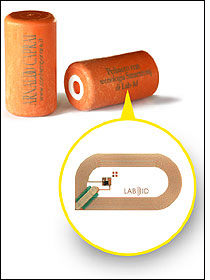Lab-ID, an Italian designer and manufacturer of RFID inlays and labels, has developed an RFID-enabled wine cork enabling winemakers to store detailed information about each bottle of wine, and to share that data with their distributors, retailers and customers.
Lab-ID has patented a system using artificial corks embedded with RFID inlays. The company believes its RFID-enabled cork, SmartCorq, will allow wine producers and consumers to provide their customers with greater assurance of the quality and provenance of each bottle of wine. The tag can be encoded with such wine data as bottling date, type of grape and alcohol percentage, along with other characteristics. Once in the bottle, the cork’s tag can be read by wine producers to help them store and distribute their products. Distributors, retailers and customers, meanwhile, can use the cork to determine specific details about each bottle of wine. Lab-ID is looking into using Near Field Communication (NFC) tags that could enable customers to use their NFC-enabled cell phones to access SmartCorq data as they browse wines in stores.
The read-write tags embedded into the corks use Philips’ ISO 15693 I-Code SLI 13.56 MHz chip with 1,024 bits of memory. Lab-ID says it has also patented a design for embedding RFID tags in natural cork. The latter won’t be available until later this year, but Lab-ID maintains there is a significant market for its RFID-enabled artificial corks.
“Around 70 percent of corks used around the world are artificial,” says Marco Astorri, executive vice president of the Bologna-based Lab ID, “and [as far as reacting with the wine or being placed into the bottle], the smart corks are exactly the same as artificial corks.”
As part of an initial technology trial, Italian winemaker Arnaldo Caprai began using SmartCorq for one of its wines in September. By April of this year, the vintner will have used 10,000 SmartCorq corks in one of its most expensive wines, according to Lab-ID. The winery produces approximately 700,000 bottles per year.
At Arnaldo Caprai’s vineyard, Lab-ID designed and deployed an RFID system consisting of about 30 fixed interrogators (readers) and between 20 and 25 handheld units, all designed by Lab-ID. Workers read and write data to the corks after they have been placed into each wine bottle. “They are using RFID in the factory to optimize the distribution process in their warehouse,” says Astorri.
While Arnaldo Caprai is the sole customer of SmartCorq at present, Lab-ID reports that several other wineries are interested in the technology, as well, and will start using it in the second half of the year.
Lab-ID maintains that while a smart label on each bottle could be encoded with similar wine-related data, an RFID-enabled cork offers greater benefits and security. “This could be done with a smart label,” Astorri acknowledges, “but that is an entry-level use of RFID because labels can get damaged more easily than corks—and unlike bottles with smart labels, corks can’t be reused.”


